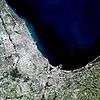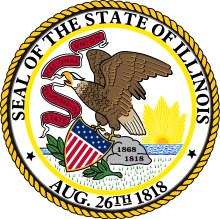Glen Ellyn, Illinois
Glen Ellyn is a village in DuPage County, Illinois, United States. A suburb located 24 miles (39 km) due west of downtown Chicago, the village had a population of 27,450 as of the 2010 Census.[4]
Glen Ellyn | |
|---|---|
Village | |
| Village of Glen Ellyn | |
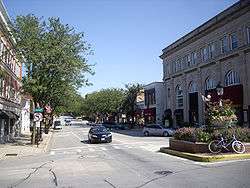 Glen Ellyn Main Street | |
| Motto(s): "Village of Volunteers" | |
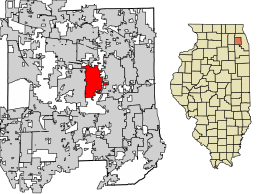 Location of Glen Ellyn in DuPage County, Illinois. | |
| Coordinates: 41°52′16″N 88°3′47″W | |
| Country | |
| State | Illinois |
| County | DuPage |
| Township | Milton |
| Settled | 1834 |
| Incorporated | May 10, 1892 |
| Government | |
| • Type | Council–manager |
| • President | Diane McGinley |
| Area | |
| • Total | 6.96 sq mi (18.04 km2) |
| • Land | 6.81 sq mi (17.63 km2) |
| • Water | 0.16 sq mi (0.41 km2) 2.36% |
| Population (2010) | |
| • Total | 27,450 |
| • Estimate (2019)[2] | 27,714 |
| • Density | 4,072.00/sq mi (1,572.31/km2) |
| Up 1.7% from 2000 | |
| Standard of living | |
| • Per capita income | $39,783 (median: $74,846) |
| • Home value | $297,293 (median: $274,800 (2000)) |
| ZIP code(s) | 60137 and 60138 (Post Office (PO.) boxes only) |
| Area code(s) | 630 and 331 |
| Geocode | 29756 |
| FIPS code | 17-29756 |
| Website | www |
| Demographics (2000)[3] | |||
|---|---|---|---|
| White | Black | Hispanic | Asian |
| 86.7% | 3% | 6.6% | 6.5% |
| Islander | Native | Other | |
| 0.01% | 0.1% | 1.83% | |
History
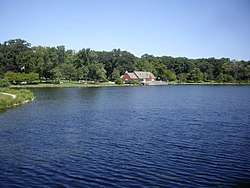

The first landowner in Glen Ellyn was Deacon Winslow Churchill. He and his family moved to Glen Ellyn from New York in 1834. Other newcomers to the area built town necessities such as a tavern and school.[5]
Moses Stacy, a soldier in the War of 1812, arrived here in 1835. His inn, Stacy's Tavern, built in 1846 and his second home, was a halfway stop between Chicago and the Fox River Valley and a probable stop for Galena, Illinois stagecoaches on their way to Rockford, Illinois. Stacy's Tavern, now a historical monument, stands at what is now the intersection of Geneva Road and Main Street.[6]
In 1849, construction of the Galena and Chicago Union Railroad through Glen Ellyn was finished. The area around the railroad became the center of the town. At first, trains running through the town on the railway did not stop there. A local man named Lewey Q. Newton made an offer to the railroad company: Newton would build a depot and water tank out of his own pocket if the railroad would require trains to stop there. The depot that Newton built became known as Newtown Station.[5]
The first church, a Congregational church, was built in 1862. Many Protestant churches were built in the village in the years to come. It wasn't until 60 years later that the first Catholic church was built.[5]
The growing settlement went through several names, including Babcock's Grove (named for three brothers that settled there), DuPage Center, Stacy's Corners (after the Stacy family), Newton's Station, Danby (after Danby, Vermont, a local landowner's birthplace) and Prospect Park.[7] The current Glen Ellyn is based on the Welsh version of the name of the then–village president Thomas E. Hill's wife Ellen, preceded by glen, referring to the local geography.[7]
The name Glen Ellyn had been adopted by 1889, when village president Hill and businessman Philo Stacy spearheaded a project to create a new lake, called Lake Glen Ellyn (today's Lake Ellyn), by having a dam built in a nearby stream.
In 1890, residents discovered mineral springs near the village.[5] This contributed to Glen Ellyn advertising itself as Chicago's newest suburb and health resort, soon followed by the Village of Glen Ellyn being officially incorporated on May 10, 1892.[8] The large Lake Glen Ellyn Hotel opened in 1892, the same year much of the business district was destroyed by fire. Fourteen years later, the hotel was struck by lightning and burned to the ground.
The village's all-volunteer fire department was created in 1907. By the end of the 20th century, it was the last all-volunteer fire department in DuPage County.[5]
By World War I, Glen Oak Country Club served the Oak Park and Glen Ellyn communities, and in 1922 the first Glenbard high school was built.
Geography
The Village of Glen Ellyn is a suburb of Chicago, and it lies about 24 miles (39 km) due west of downtown Chicago. According to the 2010 census, Glen Ellyn has a total area of 6.773 square miles (17.54 km2), of which 6.61 square miles (17.12 km2) (or 97.59%) is land and 0.163 square miles (0.42 km2) (or 2.41%) is water.[9]
Demographics
| Historical population | |||
|---|---|---|---|
| Census | Pop. | %± | |
| 1890 | 473 | — | |
| 1900 | 793 | 67.7% | |
| 1910 | 1,763 | 122.3% | |
| 1920 | 2,851 | 61.7% | |
| 1930 | 7,680 | 169.4% | |
| 1940 | 8,055 | 4.9% | |
| 1950 | 9,524 | 18.2% | |
| 1960 | 15,972 | 67.7% | |
| 1970 | 21,909 | 37.2% | |
| 1980 | 23,691 | 8.1% | |
| 1990 | 24,944 | 5.3% | |
| 2000 | 26,999 | 8.2% | |
| 2010 | 27,450 | 1.7% | |
| Est. 2019 | 27,714 | [2] | 1.0% |
| U.S. Decennial Census[10] | |||
As of the 2000 census,[11] there were 26,999 people, 10,207 households, and 7,195 families residing in the village. The population density was 4,080.6 people per square mile (1,574.7/km2). There were 10,515 housing units at an average density of 1,589.2 per square mile (613.3/km2). The racial makeup of the village was 89.50% White, 2.13% African American, 0.14% Native American, 4.74% Asian, 0.01% Pacific Islander, 1.83% from other races, and 1.66% from two or more races. Hispanic of any race composed 4.72% of the population.
There were 10,207 households, of which 36.7% had children under the age of 18 living with them. Additionally, 61.0% of households were married couples living together, 6.8% had a female householder with no husband present, and 29.5% were non-families. Individuals accounted for 25.2% of all households, and 9.3% were people 65 years of age or older living alone. The average household size was 2.63 and the average family size was 3.21.
In the village, the population was spread out, with 28.4% under the age of 18, 6.2% from 18 to 24, 30.0% from 25 to 44, 24.1% from 45 to 64, and 11.4% who were 65 years of age or older. The median age was 37 years. For every 100 females, there were 95.3 males. For every 100 females age 18 and over, there were 91.2 males.
According to 2008-2012 estimates published by the U.S. Census Bureau, the median income for a household in the village was $90,640, and the median income for a family was $123,455.[12] Males had a median income of $68,630 versus $36,287 for females. The per capita income for the village was $39,783. A total of 2.8% of the population, and 1.3% of families, had incomes below the poverty line. By age, 2.4% of those under the age of 18, and 2.0% of those 65 and older, were living below the poverty line.
Transportation
Glen Ellyn is served by the Metra Union Pacific/West Line. The Glen Ellyn station is located at 551 Crescent Blvd, near the heart of the downtown business district. The station is located 22.4 miles (36.0 km) away from Ogilvie Transportation Center, the eastern terminus of the West Line.[13]
Glen Ellyn is served by Pace bus routes 714, 715, and 301 passing through the village on Roosevelt Road.
The Illinois Prairie Path bicycle trail bisects the village and the Great Western Trail (Illinois) passes through the northern edge.
At the east end of the village, Roosevelt Road provides access onto Interstate 355.
Notable people
Glen Ellyn Park District
Glen Ellyn Park District was established on November 3, 1919 as a government agency for the community of Glen Ellyn. The facility was made to provide recreational activities such as, sports, dance, childcare and more.[14] The park district provides more than 700 programs and is open all year round. The park district's year is divided into three seasons: Fall, Winter and Spring/Summer. It has 30 parks that are maintained for the community's use in both recreational and for programmed events like youth football and softball.[14] The district counts with one outdoor aquatic facility Sunset Pool, four recreation buildings, 23 multipurpose parks and playgrounds and two lakes, including Ackerman Sports & Fitness Center and the Lake Ellyn Boathouse. The Park District launches other events like Taste of Glen Ellyn which is a great way to kick off the summer in town and surrounding areas.[14] On Fourth of July the park district puts together a firework show in Lake Ellyn for everyone in the community, also counts with a Fourth of July parade that goes around the streets of the historic downtown Glen Ellyn.[14][15]
Ackerman Sports Center
The Ackerman Sports Center is located in Glen Ellyn, Illinois it counts with an indoor track, indoor field house, indoor turf soccer field, rock climbing wall, locker rooms and a fitness center. It provides a safe environment for those who are members to the facility, it counts with a variety of activities for children and adults. It also counts with childcare hours for fitness members.[16]
Spring Avenue Recreation Center
The Spring Avenue Recreation Center often referred as "SARC" services as one of the main facilities in the Glen Ellyn Park District. The building counts with a fitness center, fitness studio, dance studios, tumbling/gymnastics facility and a crafts lab. The SARC is also host of the Glen Ellyn Park District's Board of Commissioners meetings. Offering a variety of activities for early childhood, youth and seniors, the Spring Avenue Center is the main hub of the Glen Ellyn Park District, located behind the SARC facility is a fully enclosed dog park.[17]
Main Street Recreation Center
The formerly Main Street School is also one of the main registration facilities in the Glen Ellyn Park District, it counts with surrounding park as a playground, large open play area, athletic fields, one official-sized baseball field, two dance studios, an indoor gymnasium and multi purpose rooms. The MSRC is also home to the offices of Anima - Glen Ellyn Children's Chorus.[18]
Sunset Pool Aquatic Center
Sunset Pool is a summer get away with fun and refreshing activities for early childhood, youth/adults and seniors. It counts with an outdoor, zero depth features as sloping, beach style entry as a well as the sand play area perfect for non-swimming children. It counts with water slides and a concession stand with in the facility. The sunset pool offers a variety of events from BBQ's to back to school bashes and special event rentals.[19]
Popular culture
Glen Ellyn is the setting for then-local resident O. T. Nelson‘s 1975 novel The Girl Who Owned a City. The protagonist, named Lisa Nelson after the author's real daughter, lives in the Lake Ellyn area of the village. After a virus kills all adults on the planet, she, with several other children, moved into Glenbard West High School.
Glen Ellyn and Glenbard West High School were used as the setting in the movie Lucas (1986), starring Corey Haim and featuring the film debuts of Winona Ryder, Kevin Cashman, and Courtney Thorne-Smith. The Fox Network's 1991 documentary/reality show Yearbook was filmed At Glenbard West. Glen Ellyn was also used in June 2007 for filming of the movie Witless Protection (2008), featuring Larry the Cable Guy.
Glen Ellyn is the home of the fictional character Joe Patroni, the TWA engineer in the novel Airport and played by George Kennedy in the four movies of the Airport franchise.
Education
Higher education
The main campus of College of DuPage is located in Glen Ellyn. Among its alumni are the comedian John Belushi and his actor brother James Belushi.
Public schools
Glen Ellyn's primary schools are part of Glen Ellyn School District 41 and Community Consolidated School District 89 . Its high schools are a part of Glenbard Township High School District 87, with the term Glenbard being a portmanteau of Glen Ellyn and Lombard, a village due east of Glen Ellyn.
- High schools
- Middle schools
- Glen Crest Middle School
- Hadley Junior High School
- Elementary schools
- Abraham Lincoln Elementary School
- Arbor View Elementary School
- Benjamin Franklin Elementary School
- Churchill Elementary School
- Forest Glen Elementary School
- Park View Elementary School
- Westfield Elementary School
Private schools
- Montessori Academy of Glen Ellyn
- Phillip J. Rock Center and School
- St. James the Apostle Catholic School
- St. Petronille Catholic School
- Maryknoll Montessori School
Sister city
See also
References
- "2019 U.S. Gazetteer Files". United States Census Bureau. Retrieved July 14, 2020.
- "Population and Housing Unit Estimates". United States Census Bureau. May 24, 2020. Retrieved May 27, 2020.
- 2000 United States Census Data
- "Glen Ellyn (village) QuickFacts from the US Census Bureau". State and County QuickFacts. United States Census Bureau. 8 July 2014. Retrieved 5 November 2014.
- "Glen Ellyn, IL". Encyclopedia of Chicago. Chicago Historical Society. Retrieved 10 November 2014.
- Gibula, Gary (28 October 2014). "Stacy's Tavern celebrates 40 years of historic recognition". Chicago Tribune. Retrieved 5 November 2014.
- "Several Towns Named After Founders and Heroes". The Daily Herald. December 28, 1999. p. 220. Retrieved August 17, 2014 – via Newspapers.com.

- Illinois Regional Archives Depository System. "Name Index to Illinois Local Governments". Illinois State Archives. Illinois Secretary of State. Retrieved 11 September 2013.
- "G001 - Geographic Identifiers - 2010 Census Summary File 1". United States Census Bureau. Archived from the original on 2020-02-13. Retrieved 2015-08-03.
- "Census of Population and Housing". Census.gov. Retrieved June 4, 2015.
- "U.S. Census website". United States Census Bureau. Retrieved 2008-01-31.
- Ellyn village, Illinois/POPULATION/DECENNIAL_CNT "American FactFinder - Community Facts" Check
|url=value (help). American FactFinder. United States Census Bureau. 2010. Retrieved 5 November 2014. - Metra Railfan Tips - Union Pacific/West Line
- "About the Park District • Glen Ellyn Park District". Glen Ellyn Park District. Retrieved 2018-05-06.
- "Glen Ellyn Park District | Enjoy Illinois". Enjoy Illinois. Retrieved 2018-05-06.
- "Ackerman Sports & Fitness Center | Glen Ellyn, Illinois". ackermansfc.com. Retrieved 2018-05-06.
- "Spring Avenue Recreation Center • Glen Ellyn Park District". Glen Ellyn Park District. Retrieved 2018-05-06.
- "Main Street Recreation Center • Glen Ellyn Park District". Glen Ellyn Park District. Retrieved 2018-05-06.
- "Sunset Pool • Glen Ellyn Park District". Glen Ellyn Park District. Retrieved 2018-05-06.
